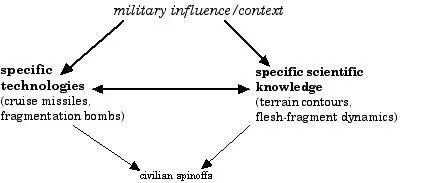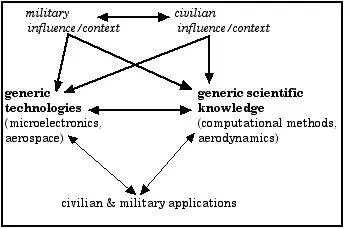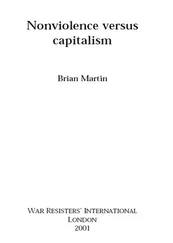The approach I take is to start with nonviolent struggle and see what implications it has for technology. Of course this is not the only way to approach these issues. Another is to start with a vision of a desired society — for example, based on participation, self-reliance, equity and ecological sustainability, as well as nonviolence — and then see what technology is most appropriate to create and sustain it. [9] . I thank Andreas Speck for emphasising this point. A theoretical foundation for this approach is given by Nicholas Maxwell, who argues that most scientific and scholarly work is based on the “philosophy of knowledge,” which assumes that knowledge is of value in itself. Maxwell argues that the philosophy of knowledge should be replaced by a “philosophy of wisdom,” in which science is directly geared to solve major problems facing humanity, such as poverty, repression and war: Nicholas Maxwell, From Knowledge to Wisdom: A Revolution in the Aims and Methods of Science (Oxford: Basil Blackwell, 1984); Nicholas Maxwell, “What kind of inquiry can best help us create a good world?,” Science, Technology, & Human Values , Vol. 17, 1992, pp. 205-227.
But in practice these two approaches are not greatly divergent, since in most cases the sort of technology suitable for nonviolent struggle is also suitable for fostering participation, self-reliance and so forth, though in a few particular areas there may be incompatibilities. I find it useful for the purpose of clarity to focus on technology for nonviolent struggle, while noting at various points the potential role of the same technology for promoting other values.
2. MILITARISED TECHNOLOGY
In order to understand the potential role of technology for nonviolent struggle, it is useful to understand the actual role of technology for military purposes. What is technology? [1] . Theories of technology are discussed in the appendix. The general model adopted here is that military and other social factors influence but do not determine technology, and that any specific technology is easier to use for some purposes than others.
A simple and narrow definition is that technology is any physical object created or shaped by humans (or other animals). Technologies include paper, toothbrushes, clothes, violins, hammers, buildings, cars, factories, and genetically modified organisms. These objects can be called artefacts. A broader definition of technology includes both artefacts and their social context, such as the processes, methods and organisations to produce and use them. This includes things such as the manufacturing division of labour, just-in-time production systems, town planning and methods used in scientific laboratories. This broader definition is useful for emphasising that artefacts only have meaning within the context of their creation and use. In this book, the word “technology” refers to both artefacts and their social context.
Similarly, “science” can be defined as both knowledge of the world and the social processes used to achieve it, including discussions in laboratories, science education, scientific journals and funding. The distinction between science and technology, once commonly made, is increasingly blurred. The scientific enterprise is deeply technological, relying heavily on instruments and associated activities. Just as importantly, the production of artefacts requires, in many cases, sophisticated scientific understanding. This is nowhere better illustrated than in contemporary military science and technology. For example, the development of nuclear weapons depended on a deep understanding of nuclear processes, and in turn nuclear technologies provided means for developing nuclear science. For convenience, I often refer just to “technology” rather than “science and technology,” with the understanding that they are closely interlinked and that each can stand in for the other.
In this chapter, I examine military influences on technology. Some influences are immediate and obvious, such as military contracts to produce bazookas and cruise missiles; others are deep and structural, such as military links with capitalism and patriarchy. My approach is to start with the immediate influences and later discuss the deep ones. The first section deals with military funding and applications, training and employment, belief systems and suppression of challenges. The second section deals with “countervailing influences,” namely factors that resist military influence on technology: civilian applications, bureaucratic interests and popular resistance. The final section discusses connections between the military and social structures of the state, capitalism, bureaucracy and patriarchy, and how they can affect technology.
Military Shaping of Technology
Military priorities play a major role in the development of many technologies. [2] . General treatments of the influence of the military on science and technology include J. D. Bernal, The Social Function of Science (London: George Routledge & Sons, 1939), chapter VII; Robin Clarke, The Science of War and Peace (London: Jonathan Cape, 1971); Paul Dickson, The Electronic Battlefield (Bloomington: Indiana University Press, 1976); Everett Mendelsohn, “Science, technology and the military: patterns of interaction,” in Jean-Jacques Salomon (ed.), Science War and Peace (Paris: Economica, 1990), pp. 49-70; Everett H. Mendelsohn, Merritt Roe Smith and Peter Weingart (eds.), Science, Technology and the Military (Dordrecht: Kluwer, 1988); Robert K. Merton, Science, Technology and Society in Seventeenth Century England (New York: Howard Fertig, 1970 [1938]); John U. Nef, War and Human Progress: An Essay on the Rise of Industrial Civilization (London: Routledge & Kegan Paul, 1950); Merritt Roe Smith (ed.), Military Enterprise and Technological Change: Perspectives on the American Experience (Cambridge, MA: MIT Press, 1985). References to specific areas are given later. On arms production and trade, see William W. Keller, Arm in Arm: The Political Economy of the Global Arms Trade (New York: HarperCollins, 1995); Keith Krause, Arms and the State: Patterns of Military Production and Trade (Cambridge: Cambridge University Press, 1992).
Figures 1 and 2 illustrate how this process, which can be called the military shaping of technology, can occur. Factors such as funding and employment are pictured as influences from the top (“military influence/context”). Military applications are shown in the middle and civilian applications at the bottom. Figure 1 shows the case of science and technology that are very specifically oriented for military purposes, such as the computer software in a cruise missile; there are only occasionally a few civilian spinoffs. Figure 2 shows a more general perspective, looking at entire fields of science and technology. In this case, civilian applications are a significant competing influence.

Figure 1. A model of military shaping emphasising military-specific science and technology.

Figure 2. A model of military shaping emphasising generic science and technology.
With figure 1, the military-specific orientation is blatant. With figure 2, it is clear that both military and civilian purposes may be served by the same general fields. I now look in more detail at the specific areas of military funding and applications, training and employment, belief systems and suppression of challenges.
Military Funding and Applications
Читать дальше














